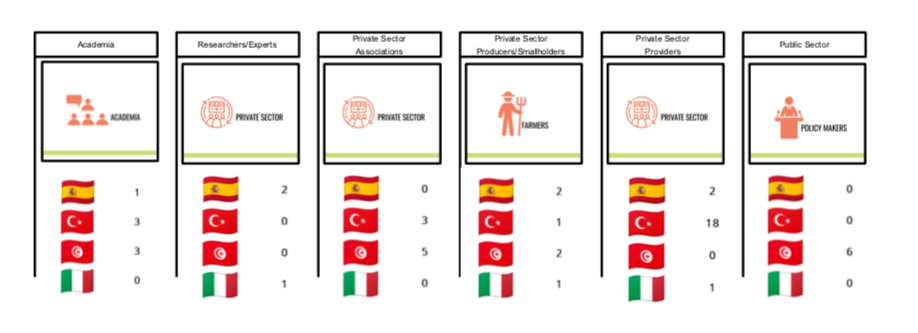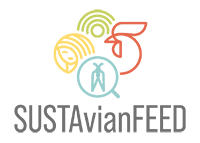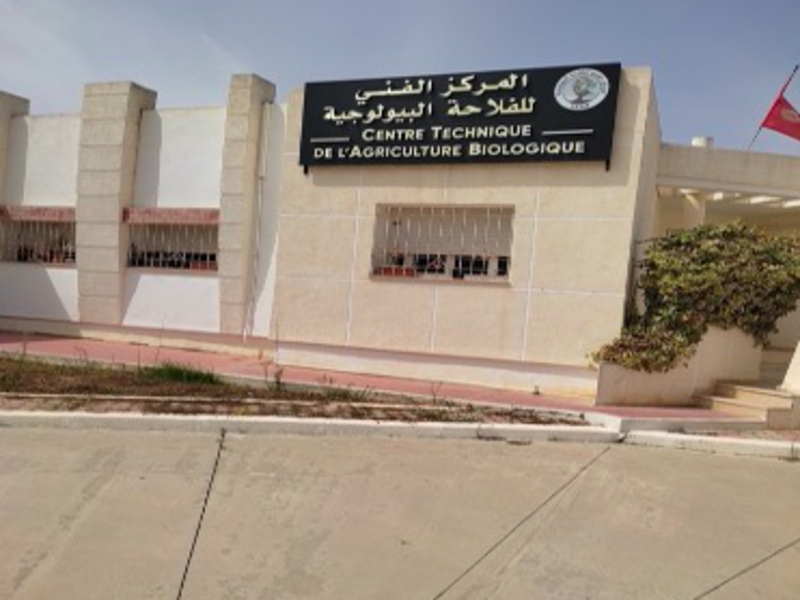SUSTAvianFEED has five main work packages (WP) which structure the activities to be developed during the 48 months of project implementation. Starting from the overall management, the project runs through the analysis of each area potentials, the scheduling of pilot activities till the promotion of the replication of these activities and the dissemination of results.
In this framework, in the last months, partners started to organize the first activities in pilot areas, to demonstrate the innovative poultry feeding approach in order to obtain sustainable products. The pilot implementation is closely related with WP4, in which the Living Lab methodology is implemented.
A Living Lab (LL) is a multi-stakeholder approach set-up to carry our innovation projects that follow the principles of open innovation and focus on real-life experimentation to co-create, test and validate novel solutions. Open innovation involves external stakeholders, mainly users or consumers, making them co-participate in the innovation process.
This work-package has the general aim of involving relevant stakeholders and end-users along the agri-food value chain for the co-creation of SUSTAvianFEED activities and solutions. These activities, among which there are participatory actions such as workshops, surveys, semi-structured interviews and others, had the main objective of improving the list of possible by-products, local ingredients, etc., to be included in the alternative nutritional diet to be developed in the project. Interactions along the agri-food supply chain were also analyzed in order to determine most important patterns and interactions among the different actors to be considered. Finally, guidelines for the development of Circular Economy Business Models (CEBM) in the agri-food sector considering project achievements will be elaborated.

The results
The results of the interviews, surveys and forum, held in different forms and at different times in all the countries involved such as Spain, Turkey, Tunisia and Italy, proved to be very interesting and key insights for further work.
The expertise and experience in the field of the persons who participated in the semi-structured interview, coming from Academia, private and public sector, was thought in order to extract new insights to be included in the formula and to confirm or change the initial ideas.
Specifically, key findings were brought to light on issues related to 7 areas as quality of the animal diet, reduction of the use of soybean, use of by-products, use of raw materials, sustainability, profitability and use of insects.
Quality of the diet
Diet is the main topic of the project and it’s a very complicated issue in animal farming. The search for alternative feed ingredients should be for the diets of slow-growing broilers rather than for fast-growing broilers. Slow-growing birds are characterized by lower nutritional requirements than broiler chickens; furthermore, these genotypes would be adapted to free-range farming systems and would provide high quality chicken meat.
It is stated that some studies are required at the regional level to make alternatives sustainable, stable and easy to use with considering antinutritional factors. Antinutritional factors are those that inhibit the absorption of nutrients. For example, in the case of laying hens, calcium plays a fundamental role not only in their own metabolic functions, but also in egg production and shell quality; its absorption may be affected by phytates and oxalates presents in some foods.
The importance of updating data relating to the nutritional value of local ingredients and by-products, in particular their levels of metabolizable energy and digestible amino acids, is fundamental to make the appropriate diet formulation adjustments and it could be interesting to supplement the alternative nutritional formula with fresh pasture (Alfalfa crop or other plant forage crops) by grazing chicken.
In particular, Living Lab revealed that the fiber is one of the main obstacles for the inclusion of alternative source of proteins and that enzymes and other additives can be useful in order to improve the fiber digestion. High fiber diets have a negative impact on the digestive tract due to their low digestibility: due to physiological differences, slow-growing birds and laying hens are more tolerant of high fiber content in their diets. Thanks to the Living Labs partners have learnt that, in general, slow-growing birds are less demanding from the point of view of nutritional needs. It seems that it has something to do with the genotypes used for each purpose. In any case, enzymes can be used to increase nutrient digestibility and improve feed conversion. It is emphasized that enzyme supplementation can reduce the soybean usage up to 30 %.
Also, synthetic amino acids should be considered to adjust for amino acids profile and content particularly that of lysine and methionine, as phytobiotics (e.g. onion, garlic, fenugreek, moringa, marjoram, basil, tomatoes, nettle and essential oils,) can be used to promote the health of chicken to be raised under an alternative farming system.
Reduction of the use of soybean
Nowadays, there is a big dependence of the soybean and basic cereals, so we need to find an
adequate alternative ingredient. The main concern is the competitiveness of a nutritional formula without soybean. 75% of the soy produced in the world is used in animal feed (mainly pigs and chickens) and is responsible, among other things, for the deforestation of the Amazon. Since 2000, also because there are not enough crops in the EU, Brazil has doubled the cutting of the primary forest to make room for soybean cultivation and today it is the first producer in the world.
Economic constraints (as prices, availability, competition with use as human food, cost per unit, amino acid supplementation and processing cost) and competition seem to be the limiting factors in terms of solutions. Even if there is no complete alternative to soybean, it is important if it is even slightly substituted.
The market imposes low production costs, and if the price of the alternatives is too high, the operators competing with the market will have difficulty replacing it. Therefore, it is stated that every option, strictly related to quality, that will minimize the raw material cost and make it sustainable is precious. It is possible to produce a soy-free formula if the price and the availability of synthetic amino acids are not a limiting factor. Other alternatives have a lower content of protein and essential amino acids and require supplementation with synthetic amino acids
Participants suggested to use, if the soybean is needed, certified or national soybean as a way to reduce its environmental impact. A more feasible and interesting alternative is represented by the reduction of soy and standard feed ingredients if slow-growing birds are used, because these birds are characterized by lower nutritional requirements than broiler chickens
Use of by-products
According to the FAO, roughly one third of the food produced in the world for human consumption every year — approximately 1.3 billion tons — gets lost or wasted. Participants agreed on the possibility that the project could be one solution to this food waste thanks to the regional by-products and ingredients inclusion for the improvement of the sustainability, but the price of these ones and their heterogeneity could be a restraining for their use.
The possibility of the use of local feed crops and by-products to develop sustainable nutritional formulas is conditioned on they are available in sufficient quantities (at least for half a year) and at a reasonable cost. The use of by-products/industry waste products is also limited due to their high moisture content. This high moisture level raises energy costs for drying.
When the bread, chips and crackers whose expiration date is approaching in the markets are collected, they can be used in feed factories by adding them to chicken diet. They should be collected daily, analyzed first and processed immediately to avoid any food contamination problems.
Some participants suggested the use of animal by-products in the nutritional formula (fish meal, and, slaughterhouse by-product meal, etc.), but – as it is known – this would involve the evaluation of greater risks related to their use
Use of raw materials
To consider the local raw materials is fundamental to reduce the cost, increase the sustainability, and ensure greater opportunities for synergies with local growers. however, is difficult to compete with the nutritional value of the soybean. Living Labs revealed that alternative raw materials should always be readily available, cheap and sustainable and that non-standard sizes of rice and bulgur can be used. There are interesting raw materials (faba beans, barley, and triticale) and by-products (rapeseed meal) that can just be used in a limited way because of their low availability.
Sustainability
Sustainability is one of the core goals of the project but also for the sector, in general, where better conditions for animals and more sustainability should be a priority. Living Lab revealed that it is important to think about the change of the system as a whole (Short cycles, short transports, etc.) and that national development priorities and strategies must be revised in the light of several environmental constraints, in particular global warming and water scarcity.
Alternative poultry farming should take conscious steps towards its long-term sustainability action plan by focusing on the circular economy concept and embedding it firmly within the farming systems processes. That includes the use of sustainably and locally produced feed resources and the application of farming techniques easily reproducible by medium and small farmers, mainly rural women.
Profitability
In order to make a competitive nutritional formula which could provide consumers with products affordable for everyone – and not the eco products which sometimes double the price of the normal ones-, it is necessary to stablish a limit for cost of the sustainable animal diet, compared to the formulas used in the intensive industry. The idea is to take into account also economic aspects in the design of the diet, so the final product obtained from this diet can be accessible for everyone. The purpose is also to evaluate the financial consequences of the proposed production system for farmers and especially smallholders in each pilot area. So partners expect to have an answer to the concerns of the breeders by the end of the project.
Use of insects.
Most of the participants in the Living Lab activities mentioned the importance of including insects as an alternative source of protein, even though that the insects were not part of the scope of the activity. Results are to be expected, also because there are some investigations conducted on the impact of feeding insect’s meal on productive performance, animal health issues and the quality of the resulting products. Moreover, there are legislative issues regarding the use of insects in poultry feed which have to be addressed in the different territories.
Next phases
A quadruple helix approach will be followed to Living Labs, and the involvement of the private sector will have a major importance. Consumers, farmers, policy makers, academia and the private sector, especially SMEs, will be engaged for the pilot definition in each pilot area.








Leave a Reply
You must be logged in to post a comment.